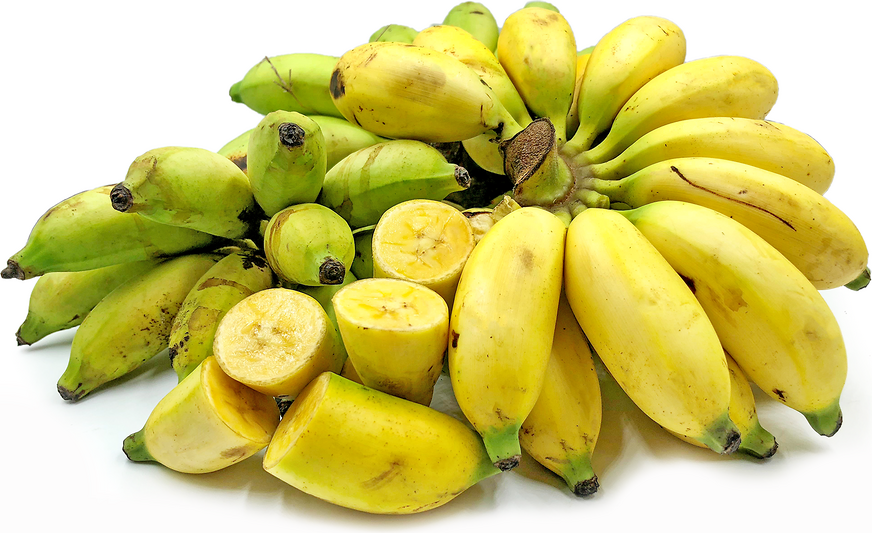


Pisang Mas Bananas
Estimated Inventory, lb : 0
Description/Taste
Pisang Mas bananas are a small varietal growing in dense, clustered hands, with the bananas averaging 2 to 3 centimeters in diameter and 10 to 14 centimeters in length. A single banana, also known as a finger, has a squat, straight to slightly curved shape, and the peel is very thin, becoming fragile and easily damaged once ripe. The peel ripens from light green to golden yellow with maturity, and the surface often features brown spots and scrapes. Underneath the peel, the yellow flesh is soft, creamy, dense, and smooth. Pisang Mas bananas emit a fruity aroma when peeled and have a tropical, sweet, and honey-like flavor.
Seasons/Availability
Pisang Mas bananas are available year-round.
Current Facts
Pisang Mas bananas, botanically classified as Musa acuminate, are a Southeast Asian variety belonging to the Musaceae family. The bananas grow on a semi-dwarf, evergreen plant that reaches up to four meters in height, and each plant can have several bunches of 10 to 14 hands with 12 to 20 fingers on each hand. Pisang Mas bananas are a diploid AA cultivar native to Southeast Asia, where they have been consumed as a fresh fruit for centuries. The name Pisang Mas translates to mean “golden banana,” a descriptor derived from the banana’s golden yellow peel and flesh. Throughout Southeast Asia, Pisang Mas bananas are known by many different names, including Sugar bananas, Sucier, Monkey bananas, Bocadillo, Kluai Khai in Thailand, Amas in the Philippines, Chuoi Trung in Vietnam, Lady Finger bananas, Date bananas, and Fig bananas. In the modern-day, Pisang Mas bananas are one of the most popular banana varieties in Southeast Asia and are traditionally consumed fresh as a dessert cultivar. The bananas are also known for their unique small size, sweet flavor, and lack of discoloration when sliced.
Nutritional Value
Pisang Mas bananas are an excellent source of fiber to regulate the digestive tract, vitamin C to strengthen the immune system, and potassium to balance fluid levels within the body. The bananas also provide other minerals such as manganese, magnesium, calcium, and zinc and lower amounts of iron, folate, B vitamins, and riboflavin.
Applications
Pisang Mas bananas have a sweet, tropical, and fruity flavor well suited for fresh and cooked preparations. The small bananas are mostly consumed raw and are highly valued as a dessert cultivar for their soft, dense, and creamy nature. Pisang Mas bananas can also be sliced and mixed into fruit salads, cut as a fresh topping over pancakes, waffles, and French toast, or skewered whole and dipped in chocolate. One of the unique features of the variety is its ability to oxidize slowly once sliced. Try layering Pisang Mas bananas into parfaits, stirring into oatmeal, or layering over smoothie bowls. In addition to fresh preparations, Pisang Mas bananas can be sautéed, fried, or caramelized in desserts. The bananas can be wrapped in puff pastry and fried, sliced and cooked into chips, grilled to develop a smoky flavor, or simmered into compotes. They can also be mixed into banana cakes, bread, and crème brulee or cooked into savory dishes such as curries and stews for added sweetness. Pisang Mas bananas pair well with aromatics such as chilies, ginger, shallot, and curry leaves, caramel, vanilla, cinnamon, pandan leaves, and fruits such as coconut, strawberries, blackberries, and mango. Whole ripened Pisang Mas bananas will keep up to one week when stored in a cool and dry place away from sunlight.
Ethnic/Cultural Info
Pisang Mas bananas are fried and consumed as a popular street food snack known as pisang goreng. The fried, crispy-sweet treat is eaten throughout Singapore, Malaysia, and Indonesia and is a simple food comprised of bananas dipped in batter and deep-fried. Historically, Pisang Mas bananas were consumed fresh, out of hand in Southeast Asia until the arrival of the Portuguese in the early 1500s. Portuguese settlers introduced flour into Southeast Asian culinary preparations around 1511, and they also demonstrated how bananas could be fried into a savory-sweet breakfast food. After this introduction, fried bananas became a favored on-the-go snack in Southeast Asia, traditionally served with coffee or tea in the morning or afternoon. In the modern-day, pisang goreng is a simple dish that chefs are elevating by pairing the fried fruits with various toppings, including cream, cinnamon sugar, fruit jams, and chocolate.
Geography/History
Pisang Mas bananas are native to Southeast Asia and have been growing wild since ancient times. Bananas were one of the first fruits to be cultivated in the early ages, and experts believe civilizations were breeding bananas as early as 8,000 BCE. Over time, many new varieties of bananas have been produced in Southeast Asia, and Pisang Mas bananas were domesticated and improved for commercial production. Pisang Mas bananas thrive in tropical, humid, and wet climates and were spread to regions worldwide through human intervention. The variety was carried to Africa, the Caribbean, South America, and Latin America and has been commercially planted for expanded production. Today Pisang Mas bananas are commonly found in local markets in Indonesia, Malaysia, Thailand, Cambodia, Singapore, Laos, Vietnam, India, and the Philippines and are located on a smaller scale in tropical regions of Africa, South America, and Central America. The bananas are also exported to China as one of the most expensive and popular dessert varieties in China.

Recipe Ideas
Recipes that include Pisang Mas Bananas. One
| Mummy Keuken |
|
Jemput -Jemput Pisang Mas..Fried Banana Ball Fritters |
Podcast



